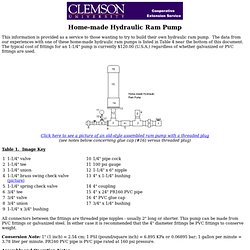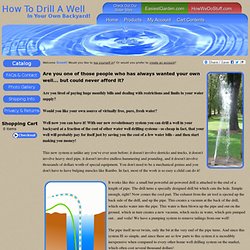

Solar Water Pump. Recycled Water by Douglas Bullock When my brothers and I got our place on Orcas Island, at the north end of Puget Sound, our idea was, 'Yeah, a solar water supply.' We had dry, sunny summers with little wind, a south and west facing hillside, and a wetland that offered virtually unlimited water at the bottom of the hill.

It seemed like a perfect match. Well, in those days money was scarce and there were a lot of projects to nickle and dime it away. After some ethical deliberation, we settled for the first decent, cheap pump we could find - a screaming, smoky two-cycle for $180.00, and used an old Dough-Boy pool for a holding tank. When the Dankoff 'Solar Forc' piston pump began showing up in ads (a light weight, low-power solar pump that could take a lot of dirt and dry running) we looked at their literature, hemmed and hawed, and said, 'That would sure be nice.' I realized we could build a setup similar to the expensive Dankoff system for far less money.
Home-made Hydraulic Ram Pump. This information is provided as a service to those wanting to try to build their own hydraulic ram pump.

The data from our experiences with one of these home-made hydraulic ram pumps is listed in Table 4 near the bottom of this document. The typical cost of fittings for an 1-1/4" pump is currently $120.00 (U.S.A.) regardless of whether galvanized or PVC fittings are used. Table 1. Image Key All connectors between the fittings are threaded pipe nipples - usually 2" long or shorter. Conversion Note: 1" (1 inch) = 2.54 cm; 1 PSI (pound/square inch) = 6.895 KPa or 0.06895 bar; 1 gallon per minute = 3.78 liter per minute. Pressure Chamber - A bicycle or "scooter tire" inner tube is placed inside the pressure chamber (part 15) as an "air bladder" to prevent water-logging or air-logging.
Table 2. Table 3. Table 4. Create An Off The Grid Source Of Water. For any off-the-gridder or survivalist, having a safe, adequate, and reliable source of water is just about as basic as it gets.

Water independence is the clear goal for all who want to be prepared for all contingencies, and digging your own well is the obvious way to set yourself up in anticipation of a time when utility companies can no longer be relied upon to supply vital services to their customers. But digging a traditional well is not the only option. There is another type of well that is perfectly capable of providing sufficient supplies of fresh, clean, potable water to meet the needs of most households, especially if at least a degree of water conservation is practiced.
Driven-point wells are a convenient and affordable alternative, and in most instances they can be installed without the use of expensive or complicated equipment, which can make them an amazing project for the hands-on type who prefers the do-it-yourself approach. Determining The Depth Of A Well. Drill A Water Well In Your Backyard! This new system is unlike any you've ever seen before; it doesn't involve derricks and trucks, it doesn't involve heavy steel pipe, it doesn't involve endless hammering and pounding, and it doesn't involve thousands of dollars worth of special equipment.

You don't need to be a mechanical genius and you don't have to have bulging muscles like Rambo. In fact, most of the work is so easy a child can do it! It works like this: a small but powerful air-powered drill is attached to the end of a length of pipe. The drill turns a specially designed drill bit which cuts the hole. Simple enough, right? The pipe itself never twists, only the bit at the very end of the pipe turns. The fastest way to start drilling your own well is to buy our completely Ready-To-Drill kit, which includes all the specialized parts and items you'll need, as well as everything else that can be shipped through the mail!
You can see our full catalog by clicking here: And don't miss our To contact us, click here. Guide To Drilling A Well. This booklet provides general information about well construction, maintenance and abandonment laws & practices in Oregon.

The information included is primarily for those individuals who wish to construct, abandon or contract for the construction or abandonment of a water well in Oregon. It may also be helpful to people wanting to buy or sell property, and to people who own land on which existing wells are located. This information is subject to change. Please call the State of Oregon Water Resources Department to verify its current applicability. The amount and quality of ground water in an area can depend on yearly rainfall, geologic conditions, topography, distance to nearby wells, and surface water supply. Hand-Digging & Bricking A Well (Mexico)